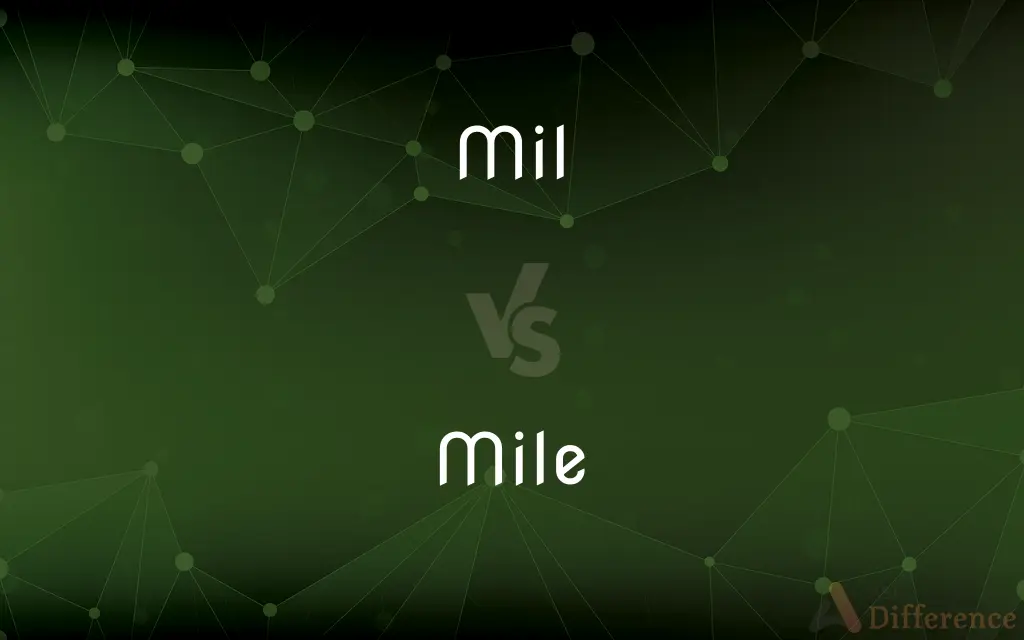Mil vs. Mile — What's the Difference?
By Tayyaba Rehman & Maham Liaqat — Updated on April 16, 2024
A mil is a unit of measurement equaling one thousandth of an inch, used primarily in engineering, while a mile is a unit of distance equal to 5,280 feet in the U.S. Customary System.

Difference Between Mil and Mile
Table of Contents
ADVERTISEMENT
Key Differences
A mil, measuring one thousandth of an inch (0.001 inch), is commonly used in manufacturing and engineering to specify thicknesses. Whereas, a mile, a much larger unit, measures distance and is commonly used for travel distances in countries using the Imperial system.
The usage of a mil is specific to certain contexts such as the thickness of plastic films or electrical wire diameter. On the other hand, the mile is universally used in the United States and the United Kingdom for road distances and in athletics.
Mil is an important unit in industries like printing and military engineering, particularly for measuring the size of components on a small scale. Conversely, the mile is crucial for navigation, mapping, and long-distance travel planning.
The mil plays a significant role in precision industries, where minute measurements are critical, such as in the production of mechanical parts. In contrast, the mile is significant in broader planning and logistics, influencing transportation and location strategies.
Understanding and converting mil measurements is vital for professionals in manufacturing and engineering, ensuring specifications are met accurately. Conversely, knowledge of mile measurements is essential for travelers, runners, and logistics planners in mile-using countries.
ADVERTISEMENT
Comparison Chart
Measurement Unit
One thousandth of an inch (0.001 inch)
5,280 feet or approximately 1.609 kilometers
Common Usage
Thickness of materials, small parts
Distance in travel, mapping
Importance
Precision in engineering and manufacturing
Navigation, transportation planning
Industry Relevance
Printing, military, manufacturing
Travel, athletics, logistics
Measurement System
Part of Imperial system
Predominantly used in Imperial system
Compare with Definitions
Mil
A unit equal to one thousandth of an inch.
The plastic sheet has a thickness of 2 mils.
Mile
A distance measure equal to 5,280 feet.
The next town is 15 miles away.
Mil
Used to measure thin material thickness.
The painter applied a coating of 10 mils thickness.
Mile
Influences urban and travel planning.
City boundaries are often described in square miles.
Mil
Influences production standards.
Mil specifications ensure product consistency in production.
Mile
A part of the Imperial system.
Miles are not used in countries that adopt the metric system, except for specific exceptions.
Mil
Important in precision measurements.
For precise electronics, a board may be milled to 1.5 mils.
Mile
Used extensively in transportation.
Road signs in the U.S. show distances in miles.
Mil
Common in the manufacturing industry.
The standard wire gauge includes measurements in mils.
Mile
Vital for mapping and navigation.
The marathon is a race over 26.2 miles.
Mil
A unit of length equal to one thousandth (10-3) of an inch (0.0254 millimeter), used, for example, to specify the diameter of wire or the thickness of materials sold in sheets.
Mile
The mile, sometimes the international mile or statute mile to distinguish it from other miles, is a British imperial unit and US customary unit of distance; both are based on the older English unit of length equal to 5,280 English feet, or 1,760 yards. The statute mile was standardised between the British Commonwealth and the United States by the international agreement in 1959, when it was formally redefined with respect to SI units as exactly 1,609.344 metres.
Mil
A milliliter; one cubic centimeter.
Mile
A unit of linear measure equal to 1,760 yards (approximately 1.609 kilometres).
Mil
A unit of angular measurement used in artillery and equal to 1/6400 of a complete revolution.
Mile
A very long way or a very great amount
Vistas which stretch for miles
This is my favourite film by a mile
Mil
(Slang) A million dollars.
Mile
By a great amount or a long way
The second tape is miles better
Mil
An angular mil, a unit of angular measurement equal to 6400 of a complete circle. At 1000 metres one mil subtends about one metre (0.98 m). Also 6000 and 6300 are used in other countries.
Mile
Abbr. mi. or mi A unit of length equal to 5,280 feet or 1,760 yards (1,609 meters), used in the United States and other English-speaking countries. Also called land mile, statute mile. See Table at measurement.
Mil
A unit of measurement equal to 1000 of an inch (25.4 µm), usually used for thin objects, such as sheets of plastic.
Mile
A nautical mile.
Mil
A former subdivision (1000) of the Maltese lira
Mile
An air mile.
Mil
Abbreviation of million
Mile
(Sports) A race that is one mile long.
Mil
(informal) milliliter; mL
Mile
A relatively great distance
Had to walk for miles in the airport.
Mil
An obsolete monetary unit of Cyprus equal in value to
Mile
The international mile: a unit of length precisely equal to 1.609344 kilometers established by treaty among Anglophone nations in 1959, divided into 5,280 feet or 1,760 yards.
Turn left in 1.2 miles.
Mil
A unit of length equal to
Mile
Any of several customary units of length derived from the 1593 English statute mile of 8 furlongs, equivalent to 5,280 feet or 1,760 yards of various precise values.
Mil
One milliliter; - used mostly in informal speech.
Mile
Any of many customary units of length derived from the Roman mile (mille passus) of 8 stades or 5,000 Roman feet.
Mil
A unit of angular size equal to
Mile
The Scandinavian mile: a unit of length precisely equal to 10 kilometers defined in 1889.
Mil
One million dollars; as, his new house cost over a mil.
Mile
Any of many customary units of length from other measurement systems of roughly similar values, as the Chinese (里) or Arabic mile (al-mīl).
Mil
A unit of length equal to one thousandth of an inch; used to specify thickness (e.g., of sheets or wire)
Mile
(travel) An airline mile in a frequent flyer program.
Mil
A Cypriot monetary unit equal to one thousandth of a pound
Mile
(informal) Any similarly large distance.
The shot missed by a mile.
Mil
A metric unit of volume equal to one thousandth of a liter
Mile
(slang) A race of 1 mile's length; a race of around 1 mile's length (usually 1500 or 1600 meters)
The runners competed in the mile.
Mil
An angular unit used in artillery; equal to 1/6400 of a complete revolution
Mile
(slang) One mile per hour, as a measure of speed.
Five miles over the speed limit
Mile
A certain measure of distance, being equivalent in England and the United States to 320 poles or rods, or 5,280 feet.
Mile
A unit of length equal to 1760 yards
Mile
A unit of length used in navigation; equivalent to the distance spanned by one minute of arc in latitude; 1,852 meters
Mile
A large distance;
He missed by a mile
Mile
A former British unit of length once used in navigation; equivalent to 1828.8 meters (6000 feet)
Mile
A British unit of length equivalent to 1,853.18 meters (6,082 feet)
Mile
An ancient Roman unit of length equivalent to 1620 yards
Mile
A Swedish unit of length equivalent to 10 km
Mile
A footrace extending one mile;
He holds the record in the mile
Common Curiosities
What are some common uses for miles?
Miles are used for measuring road distances, in athletics for races, and in geographical mapping.
How many mils are in an inch?
There are 1,000 mils in an inch.
What is a mil?
A mil is a measurement unit equal to one thousandth of an inch, primarily used to measure material thickness.
Is the mile used worldwide?
The mile is primarily used in the United States and the UK; most other countries use kilometers.
What is the significance of the mile in everyday life?
The mile is significant for driving, as distance markers and speed limits are often set in miles in the US.
Where is the mil most commonly used?
Mils are most commonly used in manufacturing, particularly where precise thickness measurements are crucial.
How does a mil compare to a mile?
A mil is a unit of thickness, whereas a mile is a unit of length; mils measure very small distances, and miles measure comparatively large distances.
Can you convert miles to kilometers?
Yes, one mile is approximately equal to 1.609 kilometers.
How are mils important in the engineering field?
In engineering, mils are used to specify the thickness of various components, critical for ensuring proper assembly and function.
Why is precision important in using mils?
Precision in using mils is critical in industries like electronics manufacturing, where even small deviations can affect functionality.
What tools are used to measure mils?
Tools such as micrometers or calipers are used to measure mils accurately in various industries.
Are mils used in medical applications?
Mils can be used in medical applications for measuring thin films or coatings on medical devices.
What historical factors influence the use of the mile?
Historical factors include its adoption through British Imperial units and its continued use in former British colonies.
How do mils affect material properties?
The thickness measured in mils can affect material properties like strength, flexibility, and transparency.
How is the mile relevant in sports?
The mile is a common distance for running events and is used in racing sports for setting race distances.
Share Your Discovery

Previous Comparison
Ambo vs. Lectern
Next Comparison
Cancel vs. DiscontinueAuthor Spotlight
Written by
Tayyaba RehmanTayyaba Rehman is a distinguished writer, currently serving as a primary contributor to askdifference.com. As a researcher in semantics and etymology, Tayyaba's passion for the complexity of languages and their distinctions has found a perfect home on the platform. Tayyaba delves into the intricacies of language, distinguishing between commonly confused words and phrases, thereby providing clarity for readers worldwide.
Co-written by
Maham Liaqat














































